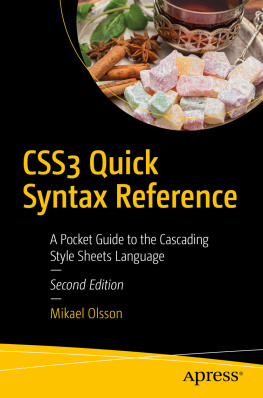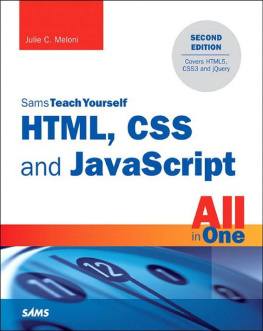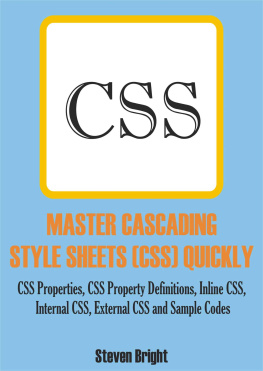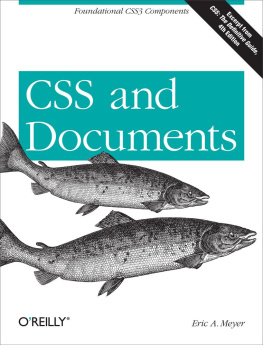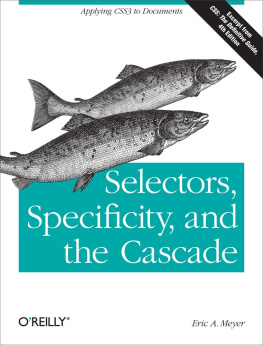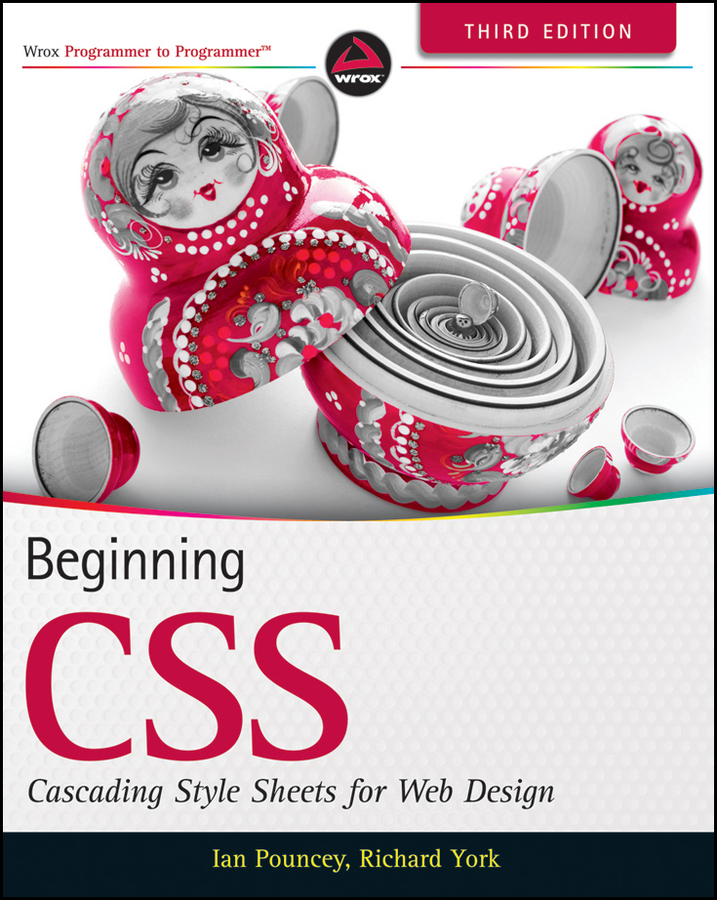PART I
The Basics
CHAPTER 1: Introducing Cascading Style Sheets
CHAPTER 2: The Bits that Make Up a Style Sheet
CHAPTER 3: Selectors
CHAPTER 4: The Cascade and Inheritance
Chapter 1
Introducing Cascading Style Sheets
WHAT YOU WILL LEARN IN THIS CHAPTER:
- What CSS is
- The history of CSS
- How to create a CSS enhanced HTML document
Cascading Style Sheets (CSS) is a language designed for describing the appearance of documents written in a markup language such as HTML. With CSS you can control the color of text, the style of fonts, the spacing between paragraphs, how columns are sized and laid out, what background images or colors are used, and a variety of other visual effects. One of the major benefits is that the same CSS can be used by more than one page, meaning that the style of an entire website can be adjusted without having to change each page individually.
The most common use for CSS is to style web pages, and in combination with HTML or XHTML (which is used to describe content) and JavaScript (which is used to add interactivity to a site), CSS is a very powerful tool.
The history of how CSS came to be isnt actually all that relevant to CSS authors of today, so you can skip the next bit if youre in a hurry. If, like me, youre interested in the nitty-gritty, read on.
In the early days of the Web, nine different proposals were made to the World Wide Web Consortium, the main standards organization for the Web which is more commonly known as the W3C, for a style sheet language to help separate the visual appearance of a document from its content. In 1994, Cascading HTML Style Sheets was proposed by Hkon Wium Lie, now CTO of Opera Software (a company youll meet again later in this chapter), but at the time he was working at CERN with Tim Berners-Lee and Robert Cailliau, the two men who invented the World Wide Web. CHSS became CSS because CSS can be applied to more than just HTML, and in December 1996 the CSS level 1 Recommendation was published.
Since then, three more CSS specifications have been published by the W3C. CSS 2 became a recommendation in 1998, with CSS 2.1 (which fixes a few mistakes in 2), and CSS 3 currently existing as candidate recommendations.
Although CSS 3 is still under development, CSS 2.1 is likely to become a fully fledged recommendation in the near future and is well supported by all modern browsers. In this book, you will cover CSS 2.1 as it stands today and take a look at some of the new features in CSS 3 that you can use in browsers today.
In the rest of this chapter, you will learn the advantages of using CSS and then get started with your first Cascading Style Sheet.
ADVANTAGES OF USING CSS
By using CSS for the presentation of a document, you can substantially reduce the amount of time you spend composing not only a single document but an entire website As youll discover, CSS is much more versatile than the styling mechanisms provided by HTML alone. The versatility of CSS, when harnessed effectively, can reduce the amount of hard disk space that a website occupies, as well as the amount of bandwidth required to transmit that website from the server to the browser. CSS has the following advantages:
- The presentation of an entire website can be centralized to one or a handful of documents, enabling the look and feel of a website to be updated at a moments notice. In legacy HTML documents, the presentation is contained entirely in the body of each document. CSS brings a much needed feature to HTML: the separation of a documents structure from its presentation. CSS can be written independently of HTML.
- Browsers are beginning to support multiple alternative style sheets, a feature that allows more than one design of a website to be presented at the same time. The user can simply select the look and feel that he or she likes most. This could only be done previously with the aid of more complex programming languages.
- Style sheets allow content to be optimized for more than one type of device. By using the same HTML document, different versions of a website can be presented for handheld devices such as PDAs and cell phones or for printing.
- Style sheets download much more quickly because web documents using CSS commonly consume less bandwidth. Browsers also use a feature called caching , a process by which your browser will download a CSS file or other web document only once, and not request that file from the web server again unless its been updated, further providing your website with the potential for lightning-fast performance.
- Users of a website can compose style sheets of their own, a feature that makes websites more accessible. For example, a user can compose a high-contrast style sheet that makes content easier to read. Many browsers provide controls for this feature for novice users, but it is CSS nonetheless.
These features, along with the power of the cascade, which you will read about in Chapter 4, makes the planning, production, and maintenance of a website simpler with Cascading Style Sheets than with HTML alone. By using CSS to present your web documents, you can cut days of development and planning time.
HOW TO WRITE CSS
To write CSS, just as is the case when writing HTML source, you will need a text editor. Word processing programs such as Microsoft Word arent ideally suited for CSS, because they automatically do lots of things that are helpful when writing a letter or book, such as correct spelling but get in the way when writing code.
Instead, you want something that doesnt make any changes that you dont want to what you type but lets you write and save plain text.
The Windows Notepad program is one example of a text editor that is ideal for composing source code. To launch Notepad, choose Start Run and then type Notepad in the Open textbox.
On Mac OS X, the Notepad equivalent is TextEdit, which can be found in the Mac OS X Applications folder.
There are more advanced text editors that will do useful things such as color your code so that it is clear which parts do what (this is known as syntax highlighting) or automatically complete code for you when youve started typing.
Editors available for Windows include:
- Notepad++: http://sourceforge.net/projects/notepad-plus/ (free)
- Crimson Editor: www.crimsoneditor.com (free)
- HTML-kit: www.chami.com/html-kit (free)
And here are some alternative text editors that work with Mac OS X:
- TextWrangler: www.barebones.com (free)
- TextMate: http://macromates.com/ (retail with 30 day free trial)
- You can find more text editors suitable for CSS and HTML at http://en.wikipedia.org/wiki/List_of_HTML_editors
In addition, there is the very popular Adobe Dreamweaver ( www.adobe.com/products/dreamweaver ), which combines a text editor with a WYSIWYG (or What You See Is What You Get) code generator, which lets you use a graphical interface to create web pages in HTML and CSS. To follow along with the code in this book, you must use the code view of Dreamweaver or similar application rather than the WYSIWYG view.
You must create HTML files with the .html extension. If you use Notepad or TextEdit, beware of your files being saved with a .txt extension, which will not result in a web browser interpreting your file as ordinary text rather than HTML.
To ensure that your files are saved properly on Windows, choose Start Run and type Explorer (or right-click Start and choose Explore from the pop-up menu) to open Windows Explorer. After Windows Explorer is open, choose Tools Folder Options to open the Folder Options window, click the View tab, and uncheck the Hide Extensions for Known File Types box. Then click OK.



